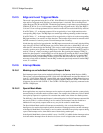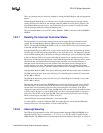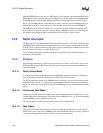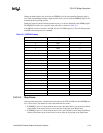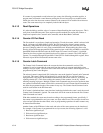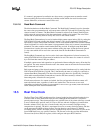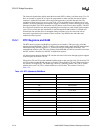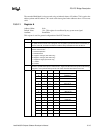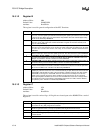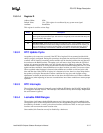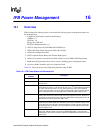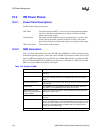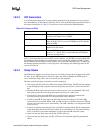
PCI/LPC Bridge Description
15-14 Intel® 460GX Chipset Software Developer’s Manual
The time and calendar data should match the data mode (BCD or binary) and hour mode (12 or 24
hour) as selected in register B. It is up to the programmer to make sure that data stored in these
locations is within the reasonable values ranges and represents a possible date and time. The
exception to these ranges is to store a value of C0 - FF in the Alarm bytes to indicate a don’t care
situation. All Alarm conditions must match to trigger an Alarm Flag, which could trigger an Alarm
Interrupt if enabled. The UIP bit should be read as 0 before each access to these registers. The SET
bit of register B should be one while programming these locations to avoid clashes with an update
cycle. Access to time and date information is done through the RAM locations. If a RAM read
from the ten time and date bytes is attempted during an update cycle, the value read will not
necessarily represent the true contents of those locations. Any RAM writes under the same
conditions will be ignored.
15.5.1 RTC Registers and RAM
The RTC internal registers and RAM are organized as two banks of 128 bytes each, called the
standard and extended banks. The first 14 bytes of the standard bank contain the RTC time and date
information along with four registers, A - D, that are used for configuration of the RTC. The
extended bank contains a full 128 bytes of battery backed SRAM, and will be accessible even when
the RTC module is disabled (via the RTC configuration register).
All data movement between the host CPU and the real-time clock is done through registers mapped
to the I/O space at locations 70-73h.
I/O locations 70h and 71h are the standard RAM location for the real-time clock. I/O locations 72h
and 73h are the extended RAM, and may be disabled. When disabled, 72h and 73h become aliases
for 70h and 71h respectively. The addressing is done by a indexing scheme: 70h (72h) is written
with the index, and 71h (73h) is written with data or read for data. This scheme is shown in
Table 15-2.
Table 15-2. RTC (Standard) RAM Bank
Index Address Name
00h Seconds
01h Seconds Alarm
02h Minutes
03h Minutes Alarm
04h Hours
05h Hours Alarm
06h Day of Week
07h Date of Month
08h Month
09h Year
0Ah Register A
0Bh Register B
0Ch Register C
0Dh Register D
0Eh - 7Fh 114 Bytes of User RAM



